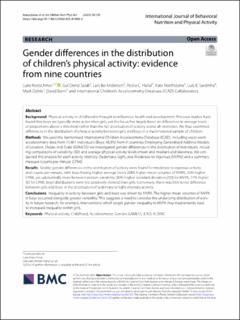| dc.contributor.author | Kretschmer, Luke | |
| dc.contributor.author | Salali, Gul Deniz | |
| dc.contributor.author | Andersen, Lars Bo | |
| dc.contributor.author | Hallal, Pedro C. | |
| dc.contributor.author | Northstone, Kate | |
| dc.contributor.author | Sardinha, Luís B. | |
| dc.contributor.author | Dyble, Mark | |
| dc.contributor.author | Bann, David | |
| dc.date.accessioned | 2024-01-09T07:48:32Z | |
| dc.date.available | 2024-01-09T07:48:32Z | |
| dc.date.created | 2023-09-19T13:01:15Z | |
| dc.date.issued | 2023 | |
| dc.identifier.citation | International Journal of Behavioral Nutrition and Physical Activity. 2023, 20 (1), . | en_US |
| dc.identifier.issn | 1479-5868 | |
| dc.identifier.uri | https://hdl.handle.net/11250/3110481 | |
| dc.description.abstract | Background: Physical activity in childhood is thought to influences health and development. Previous studies have found that boys are typically more active than girls, yet the focus has largely been on differences in average levels or proportions above a threshold rather than the full distribution of activity across all intensities. We thus examined differences in the distribution of physical activity between girls and boys in a multi-national sample of children. Methods: We used the harmonised International Children Accelerometry Database (ICAD), including waist-worn accelerometry data from 15,461 individuals (Boys: 48.3%) from 9 countries. Employing Generalised Additive Models of Location, Shape, and Scale (GAMLSS) we investigated gender differences in the distribution of individuals, including comparisons of variability (SD) and average physical activity levels (mean and median) and skewness. We conducted this analysis for each activity intensity (Sedentary, Light, and Moderate-to-Vigorous (MVPA)) and a summary measure (counts per minute (CPM)). Results: Sizable gender differences in the distribution of activity were found for moderate to vigorous activity and counts per minute, with boys having higher average levels (38% higher mean volumes of MVPA, 20% higher CPM), yet substantially more between-person variability (30% higher standard deviation (SD) for MVPA, 17% higher SD for CPM); boys’ distributions were less positively skewed than girls. Conversely, there was little to no difference between girls and boys in the distribution of sedentary or light-intensity activity. Conclusions: Inequality in activity between girls and boys was driven by MVPA. The higher mean volumes of MVPA in boys occurred alongside greater variability. This suggests a need to consider the underlying distribution of activity in future research; for example, interventions which target gender inequality in MVPA may inadvertently lead to increased inequality within girls. | en_US |
| dc.language.iso | eng | en_US |
| dc.publisher | BioMed Central (BMC) | en_US |
| dc.rights | Navngivelse 4.0 Internasjonal | * |
| dc.rights.uri | http://creativecommons.org/licenses/by/4.0/deed.no | * |
| dc.title | Gender differences in the distribution of children’s physical activity: evidence from nine countries | en_US |
| dc.type | Peer reviewed | en_US |
| dc.type | Journal article | en_US |
| dc.description.version | publishedVersion | en_US |
| dc.rights.holder | © The Author(s) 2023 | en_US |
| dc.source.pagenumber | 0 | en_US |
| dc.source.volume | 20 | en_US |
| dc.source.journal | International Journal of Behavioral Nutrition and Physical Activity | en_US |
| dc.source.issue | 1 | en_US |
| dc.identifier.doi | 10.1186/s12966-023-01496-0 | |
| dc.identifier.cristin | 2176485 | |
| dc.source.articlenumber | 103 | en_US |
| cristin.ispublished | true | |
| cristin.fulltext | original | |
| cristin.qualitycode | 2 | |

